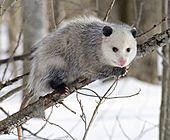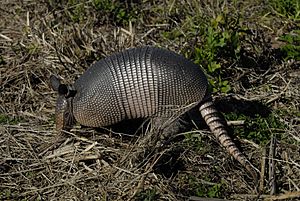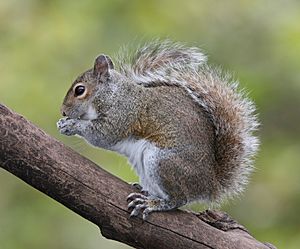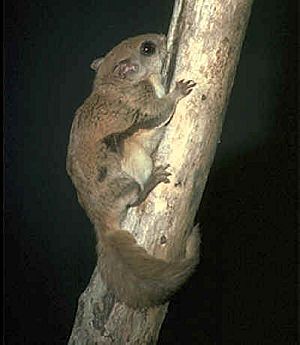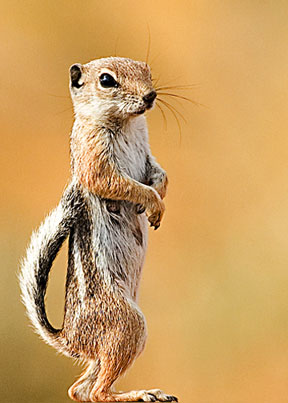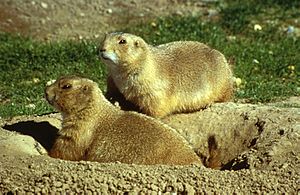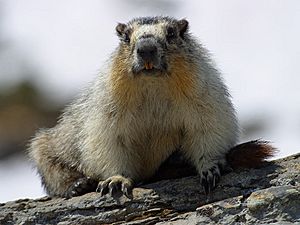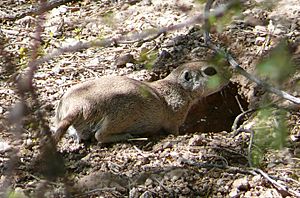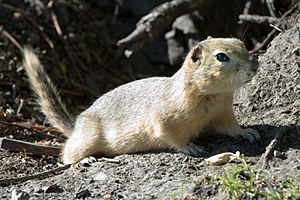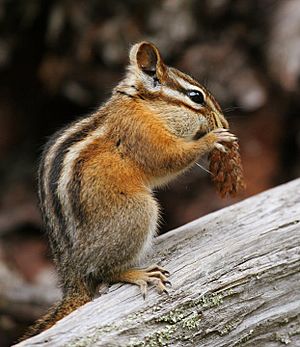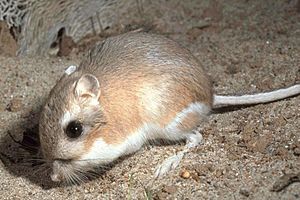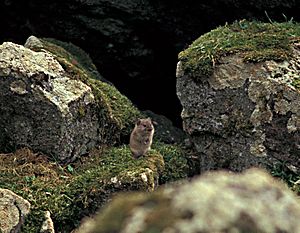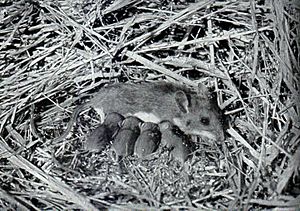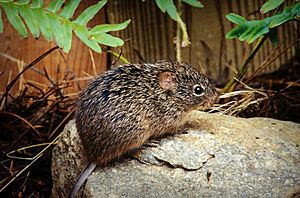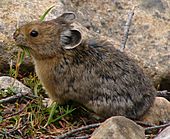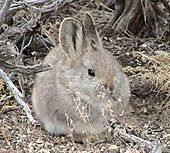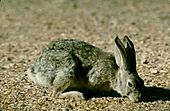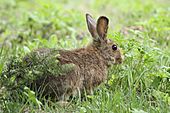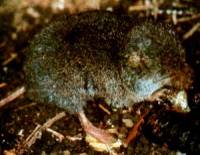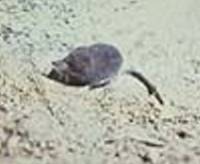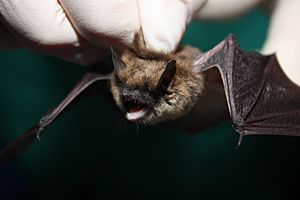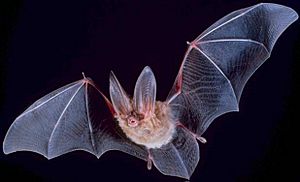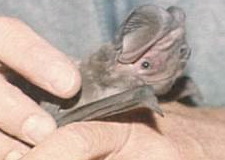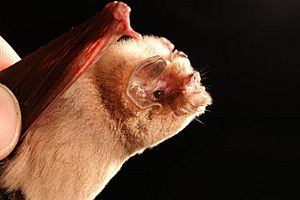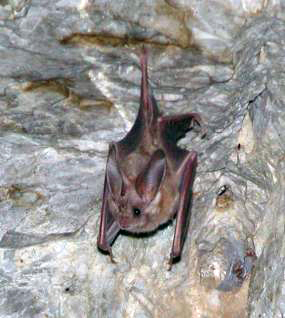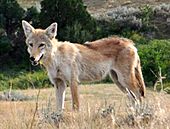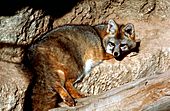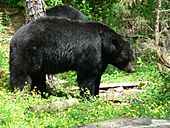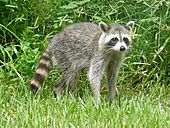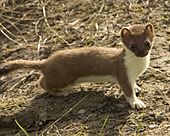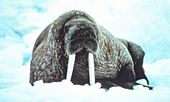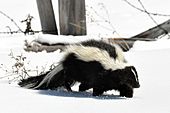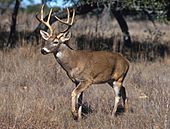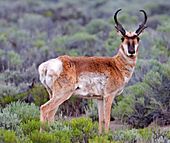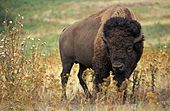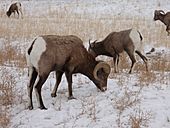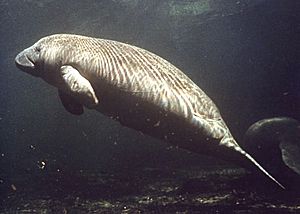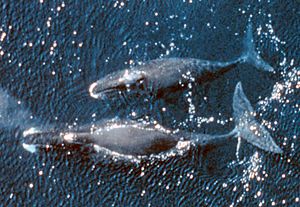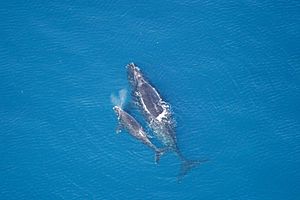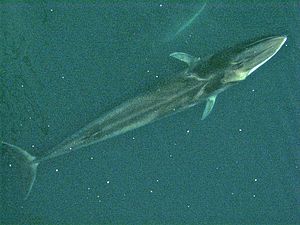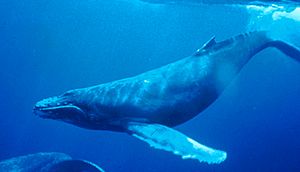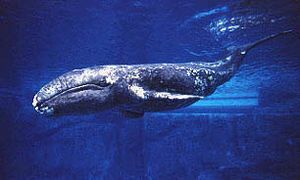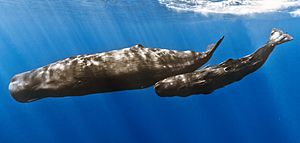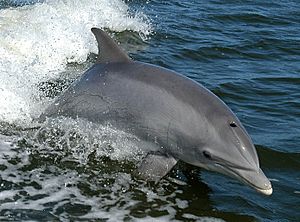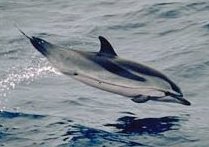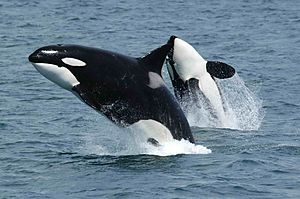List of mammals of the United States facts for kids
About 490 species of mammals are recorded in the United States. Unincorporated territories such as Puerto Rico, Guam or Northern Mariana Islands are not covered. Mammals introduced and extinct in the Holocene except Pleistocene/Holocene boundary are included.
According to the IUCN Red List 3 of these species are critically endangered, 20 endangered, 15 vulnerable, 20 near threatened and 4 extinct.
Some species are identified as indicated below:
- (A) - Accidental
- (E) - Extinct
- (Ex) - Extirpated (extinct in the US, but exists elsewhere in the world)
- (I) - Introduced
The following tags are used to highlight each species' conservation status as assessed by the International Union for Conservation of Nature:
| Extinct | No reasonable doubt that the last individual has died. | |
| Extinct in the wild | Known only to survive in captivity or as a naturalized population well outside its previous range. | |
| Critically endangered | The species is in imminent risk of extinction in the wild. | |
| Endangered | The species is facing an extremely high risk of extinction in the wild. | |
| Vulnerable | The species is facing a high risk of extinction in the wild. | |
| Near threatened | The species does not meet any of the criteria that would categorize it as risking extinction but it is likely to do so in the future. | |
| Least concern | There are no current identifiable risks to the species. | |
| Data deficient | There is inadequate information to make an assessment of the risks to this species. |
(v. 2013.2, the data is current as of March 5, 2014)
and the Endangered Species Act:
| E | Endangered |
| T | Threatened |
| XN, XE | eXperimental Nonessential or Essential population |
| E(S/A), T(S/A) | Endangered or Threatened due to Similarity of Appearance |
(the data is current as of March 28, 2014)
Contents
- Subclass: Theria
- Infraclass: Metatheria
- Infraclass: Eutheria
- Order: Cingulata (armadillos)
- Order: Rodentia (rodents)
- Order: Lagomorpha (lagomorphs)
- Order: Eulipotyphla (shrews, hedgehogs, moles, and solenodons)
- Order: Chiroptera (bats)
- Order: Carnivora (carnivorans)
- Order: Artiodactyla (even-toed ungulates)
- Order: Sirenia (manatees and dugongs)
- Order: Cetacea (whales)
- Introduced animals
- See also
Subclass: Theria
Infraclass: Metatheria
Order: Didelphimorphia (common opossums)
Didelphimorphia is the order of common opossums of the Western Hemisphere. Opossums probably diverged from the basic South American marsupials in the late Cretaceous or early Paleocene. They are small to medium-sized marsupials, about the size of a large house cat, with a long snout and prehensile tail.
- Family: Didelphidae (American opossums)
- Subfamily: Didelphinae
- Virginia opossum, D. virginiana
- Subfamily: Didelphinae
Infraclass: Eutheria
Order: Cingulata (armadillos)
The armadillos are small mammals with a bony armored shell. They are native to the Americas. There are around 20 extant species. Only the nine-banded armadillo is found in the United States.
- Family: Dasypodidae (armadillos)
- Subfamily: Dasypodinae
- Nine-banded armadillo, D. novemcinctus
- Subfamily: Dasypodinae
Order: Rodentia (rodents)
Rodents make up the largest order of mammals, with over 40% of mammalian species. They have two incisors in the upper and lower jaw which grow continually and must be kept short by gnawing. Most rodents are small though the capybara can weigh up to 45 kg (99 lb).
- Suborder: Hystricognathi
- Family: Erethizontidae (New World porcupines)
- Subfamily: Erethizontinae
- North American porcupine, E. dorsatum
- Subfamily: Erethizontinae
- Family: Erethizontidae (New World porcupines)
- Suborder: Sciurognathi
- Family: Aplodontiidae (mountain beaver)
- Mountain beaver, A. rufa (A. r. nigra: E)
- Family: Castoridae (beavers)
- American beaver, C. canadensis
- Family: Sciuridae (squirrels)
- Subfamily: Sciurinae
- Tribe: Pteromyini
- Northern flying squirrel, G. sabrinus
(Carolina northern flying squirrel G. s. coloratus, Virginia northern flying squirrel G. s. fuscus: E) - Humboldt's flying squirrel, G. oregonensis
- Southern flying squirrel, G. volans
- Northern flying squirrel, G. sabrinus
- Tribe: Sciurini
- Abert's squirrel, S. aberti
- Arizona gray squirrel, S. arizonensis
- Eastern gray squirrel, S. carolinensis
- Western gray squirrel, S. griseus
- Mexican fox squirrel, S. nayaritensis
- Fox squirrel, S. niger
(Delmarva fox squirrel, S. n. cinereus: E) - Douglas squirrel, T. douglasii
- Southwestern red squirrel, T. fremonti
(Mount Graham red squirrel, T. f. grahamensis: E) - American red squirrel, T. hudsonicus
- Tribe: Pteromyini
- Subfamily: Xerinae
- Tribe: Marmotini
- Harris's antelope squirrel, A. harrisii
- Texas antelope squirrel, A. interpres
- White-tailed antelope squirrel, A. leucurus
- San Joaquin antelope squirrel, A. nelsoni
- Gunnison's prairie dog, C. gunnisoni
- White-tailed prairie dog, C. leucurus
- Black-tailed prairie dog, C. ludovicianus
- Utah prairie dog, C. parvidens T
- Alaska marmot, M. broweri (Alaska only)
- Hoary marmot, M. caligata
- Yellow-bellied marmot, M. flaviventris
- Groundhog, M. monax
- Olympic marmot, M. olympus
- California ground squirrel, O. beecheyi
- Douglas's ground squirrel, O. douglasii
- Rock squirrel, O. variegatus
- Golden-mantled ground squirrel, C. lateralis
- Cascade golden-mantled ground squirrel, C. saturatus
- Mohave ground squirrel, X. mohavensis
- Spotted ground squirrel, X. spilosoma
- Round-tailed ground squirrel, X. tereticaudus
- Franklin's ground squirrel, P. franklinii
- Mexican ground squirrel, I. mexicanus
- Rio Grande ground squirrel, I. parvidens
- Thirteen-lined ground squirrel, I. tridecemlineatus
- Uinta ground squirrel, U. armatus
- Belding's ground squirrel, U. beldingi
- Northern Idaho ground squirrel, U. brunneus
- Southern Idaho ground squirrel, U. endemicus
- Columbian ground squirrel, U. columbianus
- Wyoming ground squirrel, U. elegans
- Arctic ground squirrel, U. parryii (Alaska only)
- Richardson's ground squirrel, U. richardsonii
- Townsend's ground squirrel, U. townsendii
- Merriam's ground squirrel, U. canus
- Piute ground squirrel, U. mollis
- Washington ground squirrel, U. washingtoni
- Alpine chipmunk, N. alpinus
- Yellow-pine chipmunk, N. amoenus
- Craters of the Moon chipmunk, N. cratericus
- Gray-footed chipmunk, N. canipes
- Gray-collared chipmunk, N. cinereicollis
- Cliff chipmunk, N. dorsalis
- Merriam's chipmunk, N. merriami
- Least chipmunk, N. minimus
- Coulee chipmunk, N. grisescens
- California chipmunk, N. obscurus
- Yellow-cheeked chipmunk, N. ochrogenys
- Palmer's chipmunk, N. palmeri
- Panamint chipmunk, N. panamintinus
- Long-eared chipmunk, N. quadrimaculatus
- Colorado chipmunk, N. quadrivittatus
- Red-tailed chipmunk, N. ruficaudus
- Hopi chipmunk, N. rufus
- Allen's chipmunk, N. senex
- Siskiyou chipmunk, N. siskiyou
- Sonoma chipmunk, N. sonomae
- Lodgepole chipmunk, N. speciosus
- Eastern chipmunk, T. striatus
- Townsend's chipmunk, N. townsendii
- Uinta chipmunk, N. umbrinus
- Tribe: Marmotini
- Subfamily: Sciurinae
- Family: Geomyidae
- Desert pocket gopher, G. arenarius
- Attwater's pocket gopher, G. attwateri
- Baird's pocket gopher, G. breviceps
- Plains pocket gopher, G. bursarius
- Hall's pocket gopher, G. jugossicularis
- Sand Hills pocket gopher, G. lutescens
- Knox Jones's pocket gopher, G. knoxjonesi
- Texas pocket gopher, G. personatus
- Strecker's pocket gopher, G. streckeri
- Southeastern pocket gopher, G. pinetis
- Llano pocket gopher, G. texensis
- Yellow-faced pocket gopher, P. castanops
- Botta's pocket gopher, T. bottae
- Camas pocket gopher, T. bulbivorus
- Wyoming pocket gopher, T. clusius
- Idaho pocket gopher, T. idahoensis
- Mazama pocket gopher, T. mazama
- Mountain pocket gopher, T. monticola
- Northern pocket gopher, T. talpoides
- Townsend's pocket gopher, T. townsendii
- Southern pocket gopher, T. umbrinus
- Family: Heteromyidae
- Subfamily: Dipodomyinae
- Agile kangaroo rat, D. agilis
- California kangaroo rat, D. californicus
- Gulf Coast kangaroo rat, D. compactus
- Desert kangaroo rat, D. deserti
- Texas kangaroo rat, D. elator
- Heermann's kangaroo rat, D. heermanni
(Morro Bay kangaroo rat, D. h. morroensis: E) - Giant kangaroo rat, D. ingens E
- Merriam's kangaroo rat, D. merriami (San Bernardino kangaroo rat, D. m. parvus: E)
- Chisel-toothed kangaroo rat, D. microps
- Fresno kangaroo rat, D. nitratoides (D. n. exilis: E, Tipton kangaroo rat, D. n. nitratoides: E)
- Ord's kangaroo rat, D. ordii
- Panamint kangaroo rat, D. panamintinus
- Banner-tailed kangaroo rat, D. spectabilis
- Stephens' kangaroo rat, D. stephensi E
- Dulzura kangaroo rat, D. simulans
- Narrow-faced kangaroo rat, D. venustus
- Big-eared kangaroo rat, D. elephantinus
- Dark kangaroo mouse, M. megacephalus
- Pale kangaroo mouse, M. pallidus
- Subfamily: Heteromyinae
- Mexican spiny pocket mouse, L. irroratus
- Subfamily: Perognathinae
- Bailey's pocket mouse, C. baileyi
- California pocket mouse, Cv californicus
- Nelson's pocket mouse, C. nelsoni
- Chihuahuan pocket mouse, C. eremicus
- San Diego pocket mouse, C. fallax
- Long-tailed pocket mouse, C. formosus
- Hispid pocket mouse, C. hispidus
- Rock pocket mouse, C. intermedius
- Desert pocket mouse, C. penicillatus
- Baja pocket mouse, C. rudinoris
- Spiny pocket mouse, C. spinatus
- White-eared pocket mouse, P. alticola
- Arizona pocket mouse, P. amplus
- Olive-backed pocket mouse, P. fasciatus
- Plains pocket mouse, P. flavescens
- Silky pocket mouse, P. flavus
- San Joaquin pocket mouse, P. inornatus
- Little pocket mouse, P. longimembris
(Pacific pocket mouse, P. l. pacificus: E) - Merriam's pocket mouse, P. merriami
- Columbia Plateau pocket mouse, P. parvus
- Subfamily: Dipodomyinae
- Family: Zapodidae (jumping mice)
- Woodland jumping mouse, N. insignis
- Western woodland jumping mouse, N. abietorum
- Meadow jumping mouse, Z. hudsonius
(Preble's meadow jumping mouse, Z. h. preblei: T)- Southern meadow jumping mouse, Z. luteus
- Western jumping mouse, Z. princeps
- Oregon jumping mouse, Z. oregonus
- South Pacific jumping mouse, Z. pacificus
- North-western jumping mouse, Z. saltator
- Pacific jumping mouse, Z. trinotatus
- Central Pacific jumping mouse, Z. montanus
- Woodland jumping mouse, N. insignis
- Family: Cricetidae
- Subfamily: Arvicolinae
- White-footed vole, A. albipes
- Red tree vole, A. longicaudus
- California red tree mouse, A. pomo
- Western red-backed vole, C. californicus
- Southern red-backed vole, C. gapperi
- Northern red-backed vole, C. rutilus (Alaska only)
- Northern collared lemming, D. groenlandicus (Alaska only)
- Nelson's collared lemming, D. nelsoni (Alaska only)
- Unalaska collared lemming, D. unalascensis (Alaska only)
- Sagebrush vole, L. curtatus
- Nearctic brown lemming, L. trimucronatus (Alaska only)
- Beringian brown lemming, L. nigripes
- Insular vole, M. abbreviatus (Alaska only)
- Singing vole, M. miurus (Alaska only)
- California vole, M. californicus (M. c. scirpen: E)
- Gray-tailed vole, M. canicaudus
- Rock vole, M. chrotorrhinus
- Western meadow vole, M. drummondii
- Florida salt marsh vole, M. dukecampbelli (M. p. dukecampbelli: E)
- Long-tailed vole, M. longicaudus
- Mexican vole, M. mexicanus
(M. m. hualpaiensis: E)- Mogollon vole, M. mogollonensis
- Montane vole, M. montanus
- Prairie vole, M. ochrogaster
- Tundra vole, M. oeconomus (Alaska only)
- Creeping vole, M. oregoni
- Eastern meadow vole, M. pennsylvanicus
- Beach vole, M. p. breweri
- Woodland vole, M. pinetorum
- Water vole, M. richardsoni
- Townsend's vole, M. townsendii
- Taiga vole, M. xanthognathus (Alaska only)
- Round-tailed muskrat, N. alleni
- Muskrat, O. zibethicus
- Western heather vole, P. intermedius
- Eastern heather vole, P. ungava
- Northern bog lemming, S. borealis
- Southern bog lemming, S. cooperi
- Subfamily: Neotominae
- Northern pygmy mouse, B. taylori
- White-throated woodrat, N. albigula
- Bryant's woodrat, N. bryanti
- Bushy-tailed woodrat, N. cinerea
- Arizona woodrat, N. devia
- Eastern woodrat, N. floridana (Key Largo woodrat, N. f. smalli: E)
- Dusky-footed woodrat, N. fuscipes (N. f. riparia: E)
- Desert woodrat, N. lepida
- White-toothed woodrat, Nv leucodon
- Big-eared woodrat, N. macrotis
- Allegheny woodrat, N. magister
- Mexican woodrat, N. mexicana
- Southern plains woodrat, N. micropus
- Stephen's woodrat, N. stephensi
- Golden mouse, O. nuttalli
- Texas mouse, P. attwateri
- Brush mouse, P. boylii
- California mouse, P. californicus
- Canyon mouse, P. crinitus
- Cactus mouse, P. eremicus
- Northern Baja deer mouse, P. fraterculus
- Cotton mouse, P. gossypinus (P. g. allapaticola: E)
- Gambel's deer mouse, P. gambelii
- Osgood's mouse, P. gratus
- Northwestern deer mouse, P. keeni
- White-ankled mouse, P. pectoralis
- Southern deer mouse, P. labecula
- White-footed mouse, P. leucopus
- Eastern deer mouse, P. maniculatus
- Black-eared mouse, P. melanotis
- Mesquite mouse, P. merriami
- Northern rock mouse, P. nasutus
- Oldfield mouse, P. polionotus (Choctawhatchee beach mouse, P. p. allophrys: E, Perdido Key beach mouse, P. p. trissyllepsis: E, St. Andrews beach mouse, P. p. peninsularis: E, Alabama beach mouse, P. p. ammobates: E, Anastasia Island beach mouse, P. p. phasma: E, Southeastern beach mouse, P. p. niveiventris: T)
- Western deermouse, P. sonoriensis
- Pinyon mouse, P. truei
- Florida mouse, P. floridanus
- Fulvous harvest mouse, R. fulvescens
- Eastern harvest mouse, R. humulis
- Western harvest mouse, R. megalotis
- Plains harvest mouse, R. montanus
- Salt marsh harvest mouse, R. raviventris E
- Subfamily: Sigmodontinae
- Chihuahuan grasshopper mouse, O. arenicola
- Northern grasshopper mouse, O. leucogaster
- Southern grasshopper mouse, O. torridus
- Coues' rice rat, O. couesi
- Marsh rice rat, O. palustris (O. p. natator: E)
- Arizona cotton rat, S. arizonae
- Tawny-bellied cotton rat, S. fulviventer
- Hispid cotton rat, S. hispidus
- Yellow-nosed cotton rat, S. ochrognathus
- Subfamily: Arvicolinae
- Family: Aplodontiidae (mountain beaver)
Order: Lagomorpha (lagomorphs)
The lagomorphs comprise two families, Leporidae (hares and rabbits), and Ochotonidae (pikas). Though they can resemble rodents, and were classified as a superfamily in that order until the early 20th century, they have since been considered a separate order. They differ from rodents in a number of physical characteristics, such as having four incisors in the upper jaw rather than two.
- Family: Ochotonidae (pikas)
- Collared pika, O. collaris (Alaska only)
- American pika, O. princeps
- Family: Leporidae (rabbits, hares)
- Pygmy rabbit, B. idahoensis E
- Antelope jackrabbit, L. alleni
- Snowshoe hare, L. americanus
- Black-tailed jackrabbit, L. californicus
- White-sided jackrabbit, L. callotis
- Alaskan hare, L. othus (Alaska only)
- White-tailed jackrabbit, L. townsendii
- Swamp rabbit, S. aquaticus
- Desert cottontail, S. audubonii
- Brush rabbit, S. bachmani (ssp. riparius: E)
- Eastern cottontail, S. floridanus
- Robust cottontail, S. holzneri
- Mountain cottontail, S. nuttallii
- Marsh rabbit, S. palustris (Lower Keys marsh rabbit, S. p. hefneri: E)
- New England cottontail, S. transitionalis
Order: Eulipotyphla (shrews, hedgehogs, moles, and solenodons)
Eulipotyphlans are insectivorous mammals. Shrews and solenodons closely resemble mice, hedgehogs carry spines, while moles are stout-bodied burrowers.
- Family: Soricidae (shrews)
- Subfamily: Soricinae
- Tribe: Blarinini
- Northern short-tailed shrew, B. brevicauda
- Southern short-tailed shrew, B. carolinensis
- Sherman's short-tailed shrew, B. shermani
- Everglades short-tailed shrew, B. peninsulae
- Elliot's short-tailed shrew, B. hylophaga
- North American least shrew, C. parva
- Berlandier's least shrew, C. berlandieri
- Tribe: Notiosoricini
- Cockrum's gray shrew, N. cockrumi
- Crawford's gray shrew, N. crawfordi
- Ticul's gray shrew, N. tataticuli
- Tribe: Soricini
- Arctic shrew, S. arcticus
- Arizona shrew, S. arizonae
- Marsh shrew, S. bendirii
- Cinereus shrew, S. cinereus
- Maryland shrew, S. fontinalis
- Long-tailed shrew, S. dispar
- Gaspé shrew, S. gaspensis
- Smoky shrew, S. fumeus
- Prairie shrew, S. haydeni
- American pygmy shrew, S. hoyi
- Western pygmy shrew, S. eximius
- Pribilof Island shrew, S. pribilofensis (Alaska only)
- Saint Lawrence Island shrew, S. jacksoni (Alaska only)
- Southeastern shrew, S. longirostris
- Mount Lyell shrew, S. lyelli
- Merriam's shrew, S. merriami
- Dwarf shrew, S. nanus
- Ornate shrew, S. ornatus (ssp. relictus: E)
- Montane shrew, S. monticolus
- Northern montane shrew, S. obscurus
- New Mexico shrew, S. neomexicanus
- Pacific shrew, S. pacificus
- Baird's shrew, S. bairdi
- American water shrew, S. palustris
- Eastern water shrew, S. albibarbis
- Western water shrew, S. navigator
- Glacier Bay water shrew, S. alaskanus (Alaska only)
- Preble's shrew, S. preblei
- Olympic shrew, S. rohweri
- Fog shrew, S. sonomae
- Inyo shrew, S. tenellus
- Trowbridge's shrew, S. trowbridgii
- Tundra shrew, S. tundrensis (Alaska only)
- Barren ground shrew, S. ugyunak (Alaska only)
- Vagrant shrew, S. vagrans
- Alaska tiny shrew, S. yukonicus (Alaska only)
- Tribe: Blarinini
- Subfamily: Soricinae
- Family: Talpidae (moles)
- Subfamily: Scalopinae
- Tribe: Condylurini
- Star-nosed mole, C. cristata
- Tribe: Scalopini
- Hairy-tailed mole, P. breweri
- Eastern mole, S. aquaticus
- Northern broad-footed mole, S. latimanus
- Southern broad-footed mole, S. occultus
- Coast mole, S. orarius
- Townsend's mole, S. townsendii
- Tribe: Condylurini
- Subfamily: Talpinae
- Tribe: Neurotrichini
- Shrew-mole, N. gibbsii
- Tribe: Neurotrichini
- Subfamily: Scalopinae
Order: Chiroptera (bats)
The bats' most distinguishing feature is that their forelimbs are developed as wings, making them the only mammals capable of flight. Bat species account for about 20% of all mammals.
- Family: Vespertilionidae
- Subfamily: Myotinae
- Silver-haired bat, L. noctivagans
- Southwestern myotis, M. auriculus
- Southeastern myotis, M. austroriparius
- California myotis, M. californicus
- Western small-footed myotis, M. ciliolabrum
- Dark-nosed small-footed myotis, M. melanorhinus
- Long-eared myotis, M. evotis
- Gray bat, M. grisescens E
- Keen's myotis, M. keenii
- Eastern small-footed myotis, M. leibii
- Little brown bat, M. lucifugus
- Arizona myotis, M. occultus
- Northern long-eared myotis, M. septentrionalis
- Indiana bat, M. sodalis E
- Fringed myotis, M. thysanodes
- Cave myotis, M. velifer
- Long-legged myotis, M. volans
- Yuma myotis, M. yumanensis
- Subfamily: Vespertilioninae
- Pallid bat, A. pallidus
- Big brown bat, E. fuscus
- Spotted bat, E. maculatum
- Allen's big-eared bat, I. phyllotis
- Eastern red bat, L. borealis
- Hoary bat, A. cinereus
- Hawaiian hoary bat, A. semotus (Hawaii only) E
- Southern yellow bat, L. ega
- Desert red bat, L. frantzii
- Seminole bat, L. seminolus
- Southern yellow bat, D. ega
- Northern yellow bat, D. intermedius
- Western yellow bat, D. xanthinus
- Evening bat, N. humeralis
- Western pipistrelle, P. hesperus
- Eastern pipistrelle, P. subflavus
- Rafinesque's big-eared bat, P. rafinesquii
- Townsend's big-eared bat, P. townsendii
(P. t. virginianus: E, P. t. ingens: E)
- Subfamily: Myotinae
- Family: Molossidae
- Wagner's bonneted bat, E. glaucinus
- Florida bonneted bat, E. floridanus E
- Western mastiff bat, E. perotis
- Underwood's bonneted bat, E. underwoodi
- Velvety free-tailed bat, M. molossus
- Pocketed free-tailed bat, N. femorosaccus
- Big free-tailed bat, N. macrotis
- Mexican free-tailed bat, T. brasiliensis
- Family: Mormoopidae
- Ghost-faced bat, M. megalophylla
- Family: Phyllostomidae
- Subfamily: Phyllostominae
- California leaf-nosed bat, M. californicus
- Subfamily: Glossophaginae
- Mexican long-tongued bat, C. mexicana
- Lesser long-nosed bat, L. yerbabuenae E
- Greater long-nosed bat, L. nivalis E
- Subfamily: Stenodermatinae
- Velvety fruit-eating bat, E. hartii
- Subfamily: Desmodontinae
- Hairy-legged vampire bat, D. ecaudata
- Subfamily: Phyllostominae
Order: Carnivora (carnivorans)
There are over 260 species of carnivorans, the majority of which feed primarily on meat. They have a characteristic skull shape and dentition.
- Suborder: Feliformia
- Family: Felidae (cats)
- Jaguarundi, H. yagouaroundi (Gulf Coast jaguarundi: E)
- Ocelot, L. pardalis E
- Margay, L. wiedii (Ex?)
- Canada lynx, L. canadensis T
- Bobcat, L. rufus
- Cougar, P. concolor T(S/A)
- Jaguar, P. onca E
- Family: Felidae (cats)
- Suborder: Caniformia
- Family: Canidae (dogs)
- Coyote, C. latrans
- Gray wolf, C. lupus E XN (Arctic wolf, C. l. arctors : E XN)
- Eastern wolf, C. lycaon
- Red wolf, C. rufus E (and XN)
- Gray fox, U. cinereoargenteus
- Island fox, U. littoralis
(U. l. littoralis: E, U. l. catalinae: E, U. l. santarosae: E, U. l. santacruzae: E) - Arctic fox, V. lagopus (Alaska only)
- Kit fox, V. macrotis (San Joaquin Kit Fox, V. m. mutica: E)
- Swift fox, V. velox (V. v. hebes: E)
- Red fox, V. vulpes
- Family: Ursidae (bears)
- American black bear, U. americanus T(S/A)
(Louisiana black bear, U. a. luteolus: T) - Brown bear, U. arctos
(Grizzly bear, Ursus arctos horribilis: T XN, California grizzly bear, Ursus arctos californicus: ) - Polar bear, U. maritimus (Alaska only) T
- American black bear, U. americanus T(S/A)
- Family: Procyonidae (raccoons)
- Ring-tailed cat, B. astutus
- White-nosed coati, N. narica
- Raccoon, P. lotor
- Family: Mustelidae (mustelids)
- Sea otter, E. lutris (E. l. nereis: T, E. l. kenyoni: T, E. l. nereis: XN)
- Wolverine, G. gulo
- North American river otter, L. canadensis
- American marten, M. americana
- Pacific marten, M. caurina
- Stoat, M. erminea
- Haida ermine, M. haidarum (Alaska only)
- American ermine, M. richardsonii
- Black-footed ferret, M. nigripes E XN
- Least weasel, M. nivalis
- Long-tailed weasel, N. frenata
- Sea mink, N. macrodon (E)
- American mink, N. vison
- Fisher, P. pennanti
- American badger, T. taxus
- Family: Otariidae (eared seals, sealions)
- Guadalupe fur seal, A. townsendi T
- Northern fur seal, C. ursinus
- Steller sea lion, E. jubatus T (E. j. monteriensis: )
- California sea lion, Z. californianus
- Family: Mephitidae
- American hog-nosed skunk, C. leuconotus
- Hooded skunk, M. macroura
- Striped skunk, M. mephitis
- Western spotted skunk, S. gracilis
- Desert spotted skunk, S. leucoparia
- Eastern spotted skunk, S. putorius
- Plains spotted skunk, S. interrupta
- Family: Odobenidae
- Family: Phocidae (earless seals)
- Hooded seal, C. cristata
- Bearded seal, E. barbatus
- Gray seal, H. grypus
- Ribbon seal, H. fasciata (Alaska only)
- Northern elephant seal, M. angustirostris
- Hawaiian monk seal, N. schauinslandi (Hawaii only) E
- Caribbean monk seal, N. tropicalis (E)
- Harp seal, P. groenlandicus
- Spotted seal, P. largha (Alaska only) T
- Harbor seal, P. vitulina
- Ringed seal, P. hispida
- Family: Canidae (dogs)
Order: Artiodactyla (even-toed ungulates)
The even-toed ungulates are ungulates whose weight is borne about equally by the third and fourth toes, rather than mostly or entirely by the third as in perissodactyls. There are about 220 artiodactyl species, including many that are of great economic importance to humans.
- Family: Tayassuidae (peccaries)
- Collared peccary, D. tajacu
- Family: Cervidae (deer)
- Family: Antilocapridae (pronghorn)
- Pronghorn, A. americana (Sonoran pronghorn, A. a. sonoriensis: E)
- Family: Bovidae (cattle, antelope, sheep, goats)
- Subfamily: Bovinae
- American bison, B. bison (Wood bison, B. b. athabascae: T)
- Subfamily: Caprinae
- Mountain goat, O. americanus
- Muskox, O. moschatus (Alaska only)
- Bighorn sheep, O. canadensis (Desert bighorn sheep, O. c. nelsoni: E, Sierra Nevada bighorn sheep, O. c. sierrae: E)
- Dall sheep, O. dalli (Alaska only)
- Subfamily: Bovinae
Order: Sirenia (manatees and dugongs)
Sirenia is an order of fully aquatic, herbivorous mammals that inhabit rivers, estuaries, coastal marine waters, swamps, and marine wetlands.
- Family: Dugongidae
- Steller's sea cow, H. gigas (Alaska only) (E)
- Family: Trichechidae
- West Indian manatee, T. manatus E (T. m. latirostris: )
Order: Cetacea (whales)
The order Cetacea includes whales, dolphins and porpoises. They are the mammals most fully adapted to aquatic life with a spindle-shaped nearly hairless body, protected by a thick layer of blubber, and forelimbs and tail modified to provide propulsion underwater.
- Suborder: Mysticeti
- Family: Balaenidae
- Bowhead whale, B. mysticetus (Alaska only) (Bering-Chukchi-Beaufort Sea subpopulation: )
- North Atlantic right whale, E. glacialis E
- North Pacific right whale, E. japonica (Alaska only) E
(Northeast Pacific subpopulation: )
- Family: Balaenopteridae
- Common minke whale, B. acutorostrata
- Sei whale, B. borealis E
- Eden's whale, B. edeni
- Bryde's whale, B. brydei
- Rice's whale, B. ricei E
- Blue whale, B. musculus E (B. m. musculus North Pacific stock: )
- Fin whale, B. physalus E
- Humpback whale, M. novaeangliae E
- Gray whale, E. robustus E
- Family: Balaenidae
- Suborder: Odontoceti
- Superfamily: Platanistoidea
- Family: Monodontidae
- Family: Phocoenidae
- Harbour porpoise, P. phocoena
- Dall's porpoise, P. dalli
- Family: Physeteridae
- Sperm whale, P. macrocephalus E
- Family: Kogiidae
- Pygmy sperm whale, K. breviceps
- Dwarf sperm whale, K. sima (Hawaii only)
- Family: Ziphiidae
- Subfamily: Ziphiinae
- Cuvier's beaked whale, Z. cavirostris
- Subfamily: Berardiinae
- Baird's beaked whale, B. bairdii
- Subfamily: Hyperoodontinae
- Northern bottlenose whale, H. ampullatus
- Tropical bottlenose whale, I. pacificus (Hawaii Islands only)
- Sowerby's beaked whale, M. bidens
- Hubbs' beaked whale, M. carlhubbsi
- Blainville's beaked whale, M. densirostris
- Gervais' beaked whale, M. europaeus
- Ginkgo-toothed beaked whale, M. ginkgodens
- Hector's beaked whale, M. hectori (A)
- True's beaked whale, M. mirus
- Perrin's beaked whale, M. perrini
- Pygmy beaked whale, M. peruvianus (A)
- Stejneger's beaked whale, M. stejnegeri
- Subfamily: Ziphiinae
- Family: Delphinidae (marine dolphins)
- Short-beaked common dolphin, D. delphis
- Long-beaked common dolphin, D. capensis
- Pygmy killer whale, F. attenuata
- Short-finned pilot whale, G. macrorhynchus
- Long-finned pilot whale, G. melas
- Risso's dolphin, G. griseus
- Fraser's dolphin, L. hosei
- Atlantic white-sided dolphin, L. acutus
- White-beaked dolphin, L. albirostris
- Northern right whale dolphin, L. borealis
- Killer whale, O. orca E
- Melon-headed whale, P. electra
- False killer whale, P. crassidens
- Pantropical spotted dolphin, S. attenuata
- Clymene dolphin, S. clymene
- Striped dolphin, S. coeruleoalba
- Atlantic spotted dolphin, S. frontalis
- Spinner dolphin, S. longirostris
- Rough-toothed dolphin, S. bredanensis
- Pacific white-sided dolphin, S. obliquidens
- Common bottlenose dolphin, T. truncatus
- Short-beaked common dolphin, D. delphis
- Superfamily: Platanistoidea
Introduced animals
- Family: Echimyidae (Echimyinae, Myocastorini)
- Coypu, M. coypus (I)
- Family: Sciuridae (squirrels)
- Mexican gray squirrel, S. aureogaster (I)
- Family: Muridae (mice, rats, voles, gerbils, hamsters, etc.)
- Subfamily: Murinae
- House mouse, M. musculus (I)
- Polynesian rat, R. exulans (I) (Hawaii Islands only)
- Brown rat, R. norvegicus (I)
- Roof rat, R. rattus (I)
- Subfamily: Murinae
- Family: Leporidae (rabbits, hares)
- Cape hare, L. capensis (I)
- European hare, L. europaeus (I)
- European rabbit, O. cuniculus (I)
- Family: Cebidae (capuchin and squirrel monkeys)
- Common squirrel monkey, S. sciureus (I)
- Family: Cercopithecidae (Old World monkeys)
- Vervet monkey, C. pygerythrus (I)
- Green monkey, C. sabaeus (I)
- Japanese macaque, M. fuscata (I) T
- Rhesus monkey, M. mulatta (I)
- Family: Herpestidae (mongoose)
- Small Indian mongoose U. auropunctata (I) (Hawaii only)
- Family: Mustelidae (mustelids)
- Beech marten, M. foina (I)
- Family: Suidae (pigs)
- Wild boar, S. scrofa (I)
- Family: Cervidae (deer)
- Chital, A. axis (I)
- Indian hog deer, A. porcinus (I)
- Red deer, C. elaphus (I)
- Sika, C. nippon (I)
- European fallow deer, D. dama (I)
- Sambar, R. unicolor (I)
- Family: Bovidae (cattle, antelope, sheep, goats)
- Subfamily: Bovinae
- Nilgai, B. tragocamelus (I)
- Subfamily: Hippotraginae
- Gemsbok, O. gazella (I)
- Scimitar-horned Oryx, O. dammah (I)
- Subfamily: Caprinae
- Barbary sheep, A. lervia (I)
- Bezoar ibex, C. a. aegagrus (I)
- Siberian ibex, C. sibirica (I)
- Himalayan tahr, H. jemlahicus (I)
- Subfamily: Antilopinae
- Blackbuck, A. cervicapra (I)
- Subfamily: Bovinae
- Family: Equidae
- Wild horse, E. ferus (Ex)
- Domestic horse, E. f. caballus (I)
- Wild horse, E. ferus (Ex)
See also
- List of mammals of Canada
- List of mammals of North America
- List of threatened mammals of the United States
- List of chordate orders
- Lists of mammals by region
- Mammal classification


